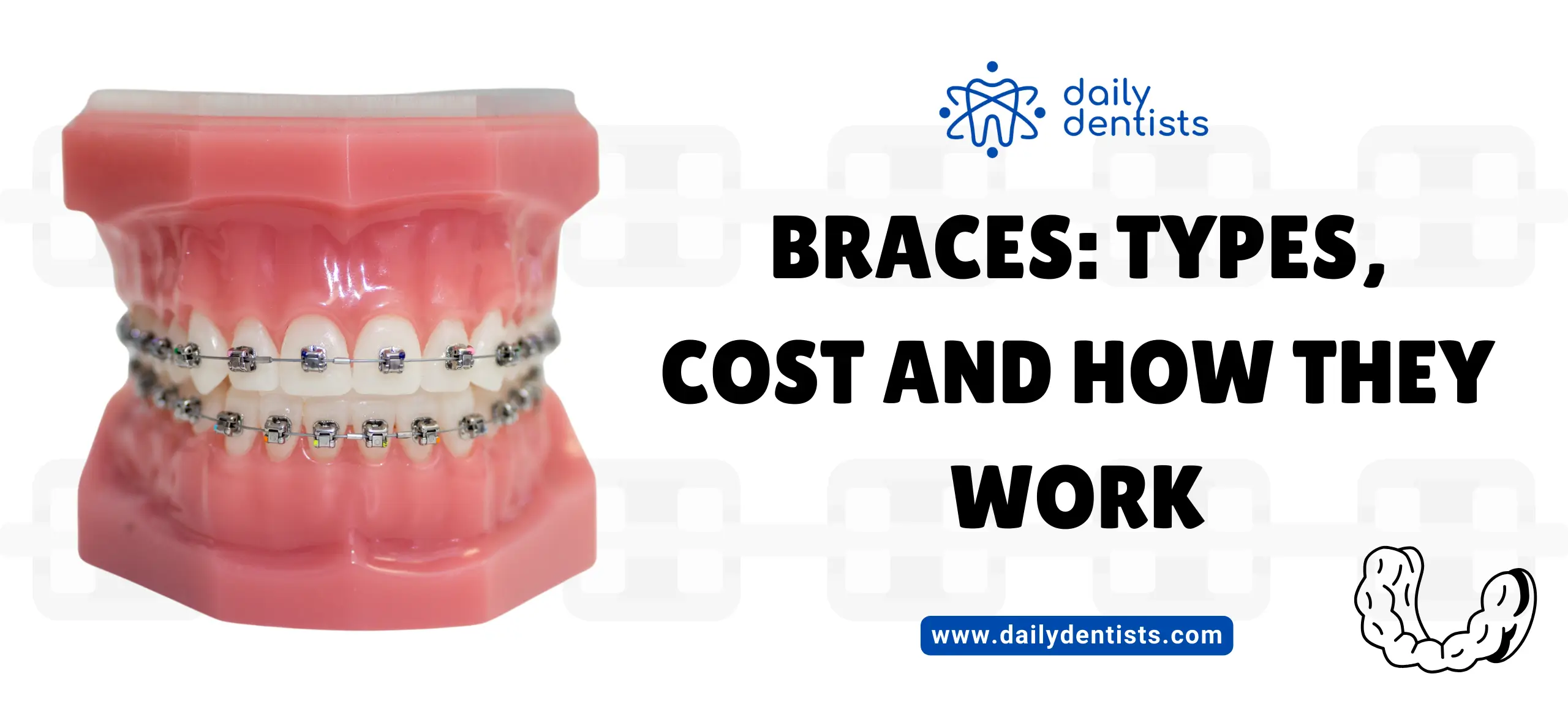Braces are a popular way to straighten teeth and improve smiles. They help fix issues like crowded teeth, gaps, and misalignment. Understanding how braces work can ease concerns. Different types of braces suit different needs and budgets. Metal braces, ceramic braces, lingual braces, and Invisalign are the main choices. And all these types of braces have their own unique benefits and cons. This guide covers the types of braces and cost, how braces work, and tips for maintaining them. If you’re considering braces, this article will help you make an informed decision.
Types of Braces
There are several types of braces available today. And all three of them have their upside and downsides. Let’s explore the main options:
1. Metal Braces
Metal braces are the traditional braces that many people are familiar with. They are made of high-grade stainless steel. Metal braces consist of metal brackets and archwires. They are the most noticeable but also the most affordable. Orthodontists often recommend them for children and teenagers.
2. Ceramic Braces
Ceramic braces are like metal braces but have clear or tooth-colored brackets. They are less noticeable than metal braces. These braces are made of ceramic material. Ceramic braces can stain if not cleaned well. Also these ceramic braces can be much costlier than its metal alternatives.
3. Lingual Braces
Lingual braces are similar to metal braces but placed on the inside of the teeth. They are completely invisible from the outside. Orthodontists custom-make them to fit each tooth. Lingual braces are harder to clean and can be uncomfortable at first. They usually cost more than other options.
4. Invisalign
Invisalign uses a series of clear, removable aligners. The comfort is one of the main features of clear aligners thus they are made of smooth plastic. They are virtually invisible. Also it provides the flexibility of removing them while eating and cleaning. Invisalign is suitable for mild to moderate dental issues. It is the most expensive option but highly popular among adults.
How Braces Work
Understanding how braces work can help ease any concerns about wearing them. Here’s a step-by-step explanation:
Initial Consultation
You will have a visit to the orthodontist. They will carefully check your teeth and jaw. The orthodontist will take X-rays and molds of your teeth.
Placement of Braces
For metal and ceramic braces, the orthodontist cleans and dries your teeth. They apply a bonding agent to hold the brackets in place. The orthodontist attaches the brackets to your teeth. They insert the archwire through the brackets. The orthodontist uses elastic bands to hold the wire in place.
Adjustments
You will visit the orthodontist regularly for adjustments. The orthodontist tightens the archwire to apply pressure to the teeth. This pressure gradually moves the teeth into the desired position. Adjustments usually occur every 4-6 weeks.
Retainers
After the braces come off, you need to wear a retainer. The retainer helps maintain the new position of your teeth. You will usually wear it full-time for a few months, then only at night.
Cost of Braces
The cost of braces varies widely based on the type and complexity of treatment. Here’s a general breakdown:
Cost of Metal Braces
The average cost of metal braces ranges from $3,000 to $7,000. Insurance may cover part of the cost.
Cost of Ceramic Braces
The average cost of ceramic braces ranges from $4,000 to $8,000. They are typically more expensive than metal braces.
Cost of Lingual Braces
The average cost of lingual braces ranges from $8,000 to $10,000. They are one of the most expensive options.
Cost of Invisalign
Invisalign typically costs between $4,000 and $7,500. They are often not covered by insurance, but payment plans may be available.
How to Maintain Braces
Proper care of braces is crucial for effective treatment and oral health. Here are some tips:
- Brushing and Flossing: Brush after every meal with a soft-bristle toothbrush. Use fluoride toothpaste. Floss at least once a day using a floss threader.
- Avoid Certain Foods: Stay away from sticky, hard, and chewy foods. Avoid gum, popcorn, and hard candies. Cut fruits and vegetables into smaller pieces.
- Regular Check-Ups: Keep all orthodontist appointments for adjustments and check-ups. Address any issues like broken brackets or wires immediately.
- Use Orthodontic Wax: Apply wax to any brackets or wires that cause discomfort. This helps prevent sores in your mouth.
- Wear a Mouthguard: If you play sports, use a mouthguard to protect your braces and teeth.
Braces are a valuable investment for a healthy, straight smile. Understanding how braces work helps in making an informed choice. There are various types of braces, each with its own benefits and costs. Metal braces are the most affordable, while Invisalign offers a nearly invisible option. Proper maintenance is crucial for successful treatment. Knowing the types of braces and cost can help you decide what’s best for you. Consult with an orthodontist to find the right fit. For more information and guidance just like this one, keep visiting our blog Daily Dentists. Because your journey to a perfect smile starts with right information and knowledge.
Most Asked Question on Braces
Are Braces Painful?
Braces can cause discomfort, especially after they are first applied and following adjustments. This discomfort usually feels like a dull ache and can last for a few days. Over-the-counter pain relievers like ibuprofen or acetaminophen can help. Orthodontic wax can ease irritation from brackets and wires.
How Fast Do Braces Work?
The time braces take to work varies based on individual cases. On average, treatment lasts between 18 months to 3 years. Factors include the severity of dental issues, the type of braces, and how well the patient follows their orthodontist’s instructions.
How Do Braces Work for Adults Compared to Children?
Braces work similarly for adults and children by applying continuous pressure to move teeth into the desired position. However, adults may require longer treatment due to denser bone tissue and the presence of dental work like crowns or implants. Adults are also more likely to need other treatments, like tooth extractions, before getting braces.
How to Clean Teeth with Braces?
Cleaning teeth with braces requires extra care:
- Brushing: Use a soft-bristle toothbrush and fluoride toothpaste. Brush after every meal. Angle the brush to clean around brackets and wires.
- Flossing: Use a floss threader or orthodontic floss to clean between teeth. Floss at least once a day.
- Mouthwash: Rinse with an antiseptic mouthwash to reduce bacteria and keep breath fresh.
- Interdental Brushes: These small brushes can clean around brackets and wires where regular brushes might not reach.
Regular Check-Ups: Visit your orthodontist for adjustments and your dentist for routine cleanings and check-ups.

